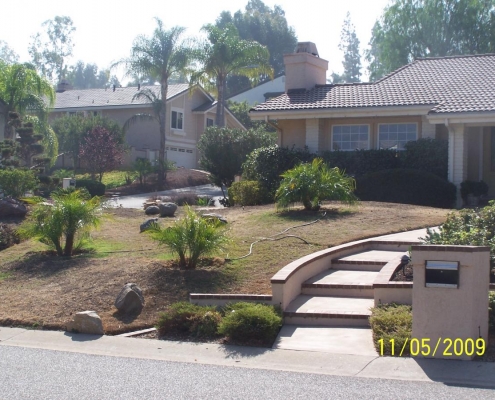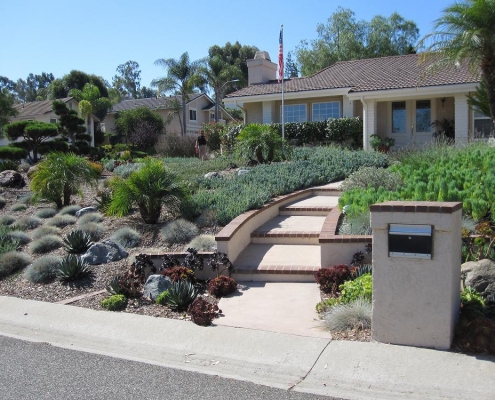Escondido Residential Site
Challenge
In 2009, Bill and Vannete Wirant decided to convert their East Coast-style landscaping to a water-wise landscape designed to work with their North County climate and soil conditions. Their property is about half an acre, nearly 50 percent of which was covered with English Ivy and cool season turf, along with Bermuda grass and other plants that demand a lot of water.
Solution
The couple’s first step was to become well-educated. Since they were planning a “do-it-yourself” project, they realized that getting informed about all aspects of their plan was essential to reach the desired results. Ten years earlier, they began converting much of their irrigation system to low-volume heads, so they had some practical experience.
As they did their research, they learned about the Water Authority’s rebate program for replacing existing water-intensive turf grass with water-efficient landscaping, and they were accepted into the program. However, plant selection posed a challenge to achieving their goal of creating an attractive, water-conserving landscape. Seeking inspiration, the Wirants made numerous trips to the Water Conservation Garden at Cuyamaca College. Nurseries such as Day Lily Hill, Evergreen Nursery, Miramar Nursery and San Marcos Growers were also great resources. The Wirants made their plant choices based on appearance, style, establishment period, ease and speed of propagation, and long-term maintenance requirements. Before starting work on the front yard, the Wirants experimented with different plants and plant palettes to see what they liked best. Then, they developed a design and had it approved by their homeowner association’s architectural review committee.
While upgrading their front yard, the Wirants decided to transform their back yard by removing existing ivy, turf, and other high-water use plants and replace them with succulents; similar to what they planned to do with the front yard.
Turf removal was the biggest challenge they faced. The Wirants experimented with different methods of removing turf; they first tried digging it up, but they lost a large amount of top soil in the process. After consulting their landscape design consultant, Steve McDearman of Design II, they used multiple applications of herbicide to kill the turf. They left the dead turf in place to stabilize the soil and provide nutrients as it decomposed, then installed new plants through the dead turf. The Wirants said they saved a lot of time, money and topsoil using that method, though it has required follow-up spot applications of herbicide.
Results
Once the front yard was planted with succulents and other water-efficient plants, many people stopped by to admire and inquire about the project. The Wirant’s project has provided inspiration for their neighbors, some of whom have transformed their landscapes as well. Water use has decreased by approximately 40% since the project was completed in 2010.



